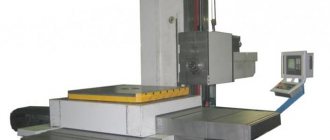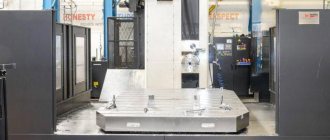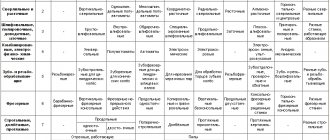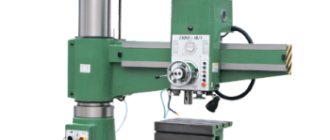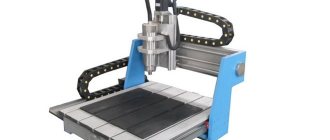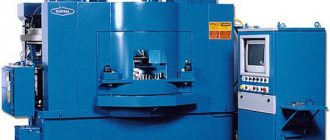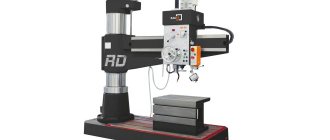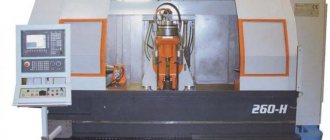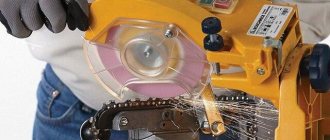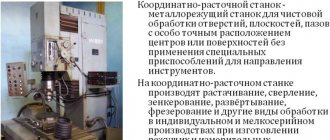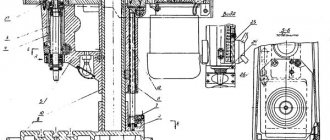Boring machines can be used for processing workpieces in conditions of both simple single production and industrial serial production. Equipment of this type can be highly specialized or universal. The latter type of machines, in turn, is divided into horizontal, diamond and coordinate boring. All these types of equipment are quite in demand in production. In this article we will understand in detail what jig boring machines are.
What are they intended for?
Such equipment is used to process holes in workpieces with precisely specified coordinates. This type of machine can be classified into:
- two-post;
- single-post.
The main advantage of jig boring machines is the high precision of parts processing. Also, the advantages of this equipment include the excellent quality of surface grinding.
Multi-Axis Capabilities
A jig drilling machine allows you to produce complex parts:
- Lugs, holes of non-standard shape.
- Shaped surfaces, cabinet products.
- Gears, gears, impellers, rotors.
- Stiffening ribs can be worked out without difficulty.
- Holes in any projection at various angles, grooves, threads.
- All complex parts requiring curved processing.
- In one cycle, the entire surface of the workpiece can be processed.
Recently, vacuum tables have been widely used to hold the workpiece by suctioning air. Classic fasteners are no longer used, which reduces the time for removing and installing a new workpiece.
Design of coordinate machines
Single-rack equipment of this type includes the following main elements:
- a cross table designed to move the workpiece in two directions (mutually perpendicular);
- bed;
- boring head.
The design of the two-column machine includes:
- racks and bed;
- boring heads;
- table;
- traverse
The cutting tool in such machines can move in polar and rectangular coordinates. The basis of this type of equipment is the frame. This element consists of two flat and one T-shaped guides. Sleds move along them during operation. Also mounted on the frame are a control panel and a coordinate set device.
The racks house such elements as a guide block, a gearbox, and a V-belt drive casing.
Horizontal boring machines
The main distinctive feature of a horizontal boring machine (Fig. 1) is the horizontal arrangement of the spindle. This type of machine is somewhat reminiscent of a conventional screw-cutting lathe. But there are several key differences in a horizontal boring machine. Firstly, the tailstock is missing. Instead of the tailstock, a movable rest is installed. Secondly, the faceplate with which the spindle is equipped has the ability to shift the cutter relative to the axis of rotation, which is not typical for a lathe. Thirdly, there is a table on which the part can be fixed.
Figure 1. Horizontal boring machine
Figure 1. Horizontal boring machine
Let's look at the main components and elements that make up a standard horizontal boring machine.
- Rear pillar. It is designed to attach a movable rest to it. Can be moved on the bed guides. Has a lever to lock the position.
- Lunette. This device is designed to hold the tail part of the workpiece if its length does not allow for reliable fastening to the table. Serves as an additional attachment point. The lunette can move in a vertical plane. Movement in the horizontal plane is carried out through the movement of the rear pillar.
- Front pillar. The main support on which the working part of the machine is mounted is the spindle head. On the front pillar there are vertical guides along which the headstock moves.
- Caliper. This element of a horizontal boring machine serves to feed the cutter to the surface of the workpiece. The support has the ability to move longitudinally in a horizontal plane along the axis of rotation.
- Faceplate (Fig. 2). Unlike the standard faceplate of lathe group machines, it is used to secure the boring cutter in it. It has the ability to shift the cutter relative to the axis of rotation. This allows one tool to perform various boring operations.
- Spindle. Transmits rotational motion from the gearbox to the faceplate.
- Grandma. The working moving part of a horizontal boring machine. Inside the headstock there is an electric motor, gearbox and guides for axial movement of the caliper.
- Remote Control. Includes buttons for changing operating speed, reverse, automatic feed settings and emergency stop.
- Table. Serves for arranging and securing massive parts of small dimensions on it.
- Sled. Used to move the table.
- Bed. It is the base of the machine. On the bed there are two racks and a table. Sometimes the bed has the ability to adjust the installation level of the machine.
Figure 2. Boring machine faceplate.
Figure 2. Boring machine faceplate.
Today, horizontal boring machines that are equipped with a numerical control module are becoming increasingly common.
Operating principle
The work table of a jig boring machine is designed to secure the workpiece on it and move it in the direction of the X axis. The table itself (together with the installed workpiece) moves along the slide along the Y axis.
The main purpose of boring machines of this type, as already mentioned, is to make holes in parts at precisely specified coordinates. This becomes possible due to the presence of optical devices and glass precision rulers in the equipment design. The latter have thousands of divisions.
Work is carried out on a jig boring machine as follows:
- the workpiece is fixed on the table;
- the cutting tool is fixed in the spindle;
- the traverse and boring head are fixed by the operator at the required height (depending on the dimensions of the workpiece).
Setting the spindle to specified coordinates can occur thanks to:
- moving the table in two directions perpendicular to each other (single-column machines);
- moving the table longitudinally and moving the head along the traverse in the transverse direction (two-post equipment).
Design and principle of operation
The coordinate machine has the following design:
- a work table that moves in two directions along the X and Y axis; the workpiece being processed is fixed on it;
- the stand and bed are made of high quality cast iron, metal guides and a machine control panel are installed on them;
- traverse;
- boring heads.
To perform boring, workers should perform the following manipulations:
- securing the part on the work table in a special device;
- a cutting tool is installed in the spindle cone;
- The height of the traverse with the tool depends on the size of the part.
In order to set the spindle to certain coordinates, the table is moved relative to the cutter. In industry, there are several types of tools for coordinate machines:
- checkpoints;
- pruning;
- groove;
- threaded;
- drill;
- countersinks and countersinks;
- scans.
Boring holes (Photo: Instagram / remplazmatsentr)
What kind of boring cutters are used for jig boring machines?
The working tool in such equipment is pre-fixed in the spindle hole. Cutters in jig boring machines can be used:
- pass-through and cutting;
- grooved and threaded.
Also, drills, countersinks, reamers, taps and cutters can be installed on such a machine. Most often, operators work on this type of equipment using a boring tool made in the form of a cantilever mandrel with a rod cutter fixed in it. On machines supplemented with CNC, prefabricated tools can also be used, consisting of a head, a unified tail and an extension element.
The most popular manufacturers
Several companies produce jig boring machines in our country. The largest producers are:
- CJSC "Stan-Samara";
- JSC MZKRS (Moscow).
The Stan-Samara jig boring machines plant is a relatively new enterprise. This company was registered in 1991 on the basis of the Kuibyshev KZKRS. Currently, the company manufactures jig boring machines, grinding and rotary tables and some other similar equipment.
MZKRS is the oldest enterprise, founded in 1942. The first high-precision jig boring machine at this plant was produced back in 1948.
Application area
Multi-axis machines are in demand from almost any manufacturer of metal products, furniture, plastics, and unique products. The largest number of coordinate systems are found in the automobile and aircraft industries, and the space industry. Such machines can also be seen at sheet material cutting sites.
Vertical multi-axis centers are mobile and can be easily installed on a flat surface in a new location. Manufacturers provide the possibility of upgrading equipment by adding axes; accordingly, the memory and the number of inputs on interface boards have to be increased. From a 3-axis center, 5 or 6-axis systems can be easily achieved.
Best models
The most popular manufacturers of jig boring machines, therefore, are MZKRS and Stan-Samara. The most popular models in production are:
- jig boring machine 2A450;
- model 2D450;
- machine 2V440A;
- equipment 2431;
- machine 2421.
What technical characteristics these machines have can be seen in the table below.
| Parameter | 2A450 | 2D450 | 2V440A | 2431 | 2421 |
| Working surface of table (mm) | 1100 x 630 | 800 x 400 | 560 x 320 | 450 x 250 | |
| Machine weight (kg) | 7300 | 7800 | 3630 | 2510 | 1610 |
| Minimum/maximum hole diameter (mm) | 30/250 | 25/250 | 18/125 | 12/80 | |
| Maximum weight of workpiece processed (kg) | 600 | 320 | 250 | 150 | |
| Spindle speed (revolutions per minute) | 50-2000 | 75-3000 | 135-3000 | ||
| Total power of electric motors (wKt) | 4,5 | 2 | 2,2 | 2,81 | 10 |
All these models of jig boring machines are distinguished by reliability, high productivity and maintainability. Such machines can be used at enterprises in the metallurgical industry, mechanical engineering, etc.
Design and operating characteristics of the main components of the jig boring machine 2450
Operation diagram of the main jig boring machine 2450
In tool production, all three machine designs find equal application. Let's consider the most advanced one - a machine of the third design. This is a coordinate marking, drilling and boring machine model 2450 with optical displacement counting.
By the nature of the movements of the main parts, such a machine (Fig. 93) is similar to a vertical milling machine, but it has one more additional movement - the vertical feed of the spindle. It consists of a frame 1 with an electric motor installed on it, a spindle box 2, a spindle 3, a work table 4, its 6T slide mechanism for longitudinal and transverse movements of the work table and devices for counting these movements. The machine spindle speed can vary from 50 to 1900 rpm, and its automatic vertical feed is from 03 to 0.18 mm per revolution. Both the speed and spindle feed are steplessly adjustable.
Counting table movements
In this design, the greatest complexity and interest are the devices for moving the desktop and measuring their magnitude. The transverse movement of the worktable is carried out by a special electric motor or handwheels 11 and 12. From them, the movement is transmitted to a worm pair 14 and a gear 15 located on the frame. The worm gear and gear move the slide with the help of a gear rack 16 installed on them. A similar device is also used for longitudinal movements. Oho also consists of a worm gear 17, a gear 18 and a rack 19 connected to the work table. This mechanism is driven by an electric motor or by the above-mentioned handwheels 11 to 12.
However, the task is not only to move the table to some strictly defined distance. It is necessary to be able to accurately measure the magnitude of this movement. Such readings are made using a transverse movement counter 10 and a longitudinal movement counter 13. The counters indicate whole millimeters and their halves using a cylindrical measuring ruler 21 for transverse movement and a ruler 22 for longitudinal movement, lighting devices 20 and 7 and optical systems with eyepieces 9 and 8 , bringing the reading accuracy to thousandths of a millimeter. The measuring rulers are long polished stainless steel rollers, on the surface of which a precise and thin helical line is applied in increments of 2 mm. Parallel beams of light emerging from the lighting devices 7 and 20 fall on the mirrors 8 and 9, illuminate the helical line of the rulers and carry its image through prisms and lenses to the eyepieces of the optical systems. Two parallel lines are visible in the eyepieces and the image of a small section of the helical line of the measuring ruler is magnified 60 times.
Moving the table
Let's see how to move the table by a given amount.
Let's assume that it is necessary to move it by 241.125 mm. First of all, you need to establish the actual position of the table. For this purpose, the risks of the optical device are set so that the helix visible through the eyepiece is in the middle between these risks. Then the table is moved until the counter shows a difference of 241 mm. After this, using the dividing drum 5 and its vernier, rotate the cylindrical measuring ruler by 0.125 mm and, looking into the eyepiece, move the table again with the handwheel 11 until the image of the helix is between the eyepiece marks. As a result, the table will be moved by a specified amount.
Errors in the distance between the axes of holes bored on the described machine do not exceed ± 0.01 mm.
Adaptations
Coordinate machines are equipped with various accessories that give them wide versatility. The main devices that are available on coordinate marking and drilling machines are:
- a. round indexing table for machining circular holes
- b. a round universal table for processing holes located obliquely to the supporting surface of the part.
All coordinate marking, drilling and boring machines require especially careful handling and are carefully protected from damage, sudden temperature fluctuations and dust. For this purpose, they are installed in special closed and warm rooms.
Imported equipment
Most often, Russian enterprises use, of course, domestic, relatively inexpensive machines. But sometimes factories in our country also install imported horizontal boring equipment. For example, machines from the Newall brand (England) are quite popular. The modern model 1520 from this manufacturer has a table width of 380 mm and a length of 530 mm. Also on the domestic market, although quite rarely, you can find jig boring machines of the WKV and WHN brands.
Advantages of CNC models
Quite expensive imported CNC (for example, brands Newall, Funac, etc.) are often installed on domestic jig boring machines. The use of old models improved in this way gives the company the following advantages:
- reduction of labor costs up to 80%;
- increase in labor productivity up to 50%;
- increasing the accuracy of parts manufacturing by 3 times.
One CNC machine in some cases can replace three conventional ones. As a result, it becomes possible to reduce the area and staff of workers at the plant. Another advantage of using such an add-on for jig boring machines, such as CNC, is the improvement in the quality of the produced parts.
Jig boring machines - promising equipment
The models discussed above are actually in great demand in factories. These machines are powerful, reliable and productive. However, unfortunately, all these models are morally somewhat outdated. Some of these jig boring machines have been in production for 30-40 years. Sometimes wear and tear on components and parts of such models can even cause problems with their operation.
This situation at the enterprise can be corrected by modernizing the jig boring machine. The characteristics of such equipment will be significantly improved if:
- installation of an electronic reading measuring system with photoelectric converters and digital display instead of optics;
- installation of a programmable controller for creating electrical automation circuits instead of relay control;
- replacement of rack and pinion gears and worm gearboxes with ball screw pairs and high-torque adjustable DC motors;
- replacing electromechanical clamps on tables and slides with pneumatic ones;
- mechanization of movements of spindle boxes;
- installation of a sleeve movement drive with a DC motor.
Most often, the same companies that supply them to the market are involved in the modernization of machines. At the same time, customers do not have to wait too long for equipment reconstruction. Instead of a delivered machine, company representatives can immediately pick up exactly the same one, but already modernized.
Main characteristics
Founded back in the USSR, the plant produced several models of K.R machine tools for industry. Among them are the following:
- Jig boring machine 2431 - its main purpose is to perform finishing operations using parts that do not exceed 250 kg. and which can perform precise machining of holes and their surfaces. This unit is intended for the watchmaking, radio engineering, and instrument-making industries.
- Jig boring machine 2a450 - this unit allows you to machine holes where the specified dimensions between them are located in a rectangular coordinate system. It also checks center-to-center distances and linear quantities. The 2a450 jig boring machine has its advantages, including the fact that the counting device installed on it is capable of calculating not only whole, but also fractional coordinate sizes.
- 2d450 jig boring machine - performs the same actions as the previous type of equipment, taking into account the fact that it is equipped with maneuverable tabletops, which allow processing parts with inclined and mutually perpendicular holes, and turning end planes. At the same time, the 2d450 boring machine can process a workpiece weighing up to 600 kg.
- The 2421 jig boring machine is a single-column unit that has the highest accuracy and also has an optical reference system. It is used in instrument making, where parts can weigh up to 150 kg. In addition, the 2421 jig boring machine has additional equipment, which includes other devices, including a cutting tool, which significantly increases its functionality.
- Jig boring machine 2v440a - using this equipment, holes with a diameter of up to 40 mm are drilled. In addition to checking the functions of linear dimensions and center-to-center distances, you can perform milling work of little complexity.
- Jig boring machine 2e440a - in addition to boring, this unit can be used for light drilling and milling. The 2e440a jig boring machine includes a rectangular table that can move both longitudinally and transversely and is manually adjustable.
- CNC jig boring machine - this type of equipment allows you to process parts, stamping, and make molds, which require special precision in small-scale and large-scale production of products. Due to the fact that the CNC jig boring machine has a universal maneuverable table included in the kit, elements are processed at any angle regardless of the plane of the table.
- K.R. The 2a430 machine is an equipment that has a cross-shaped table, as well as an inductive measuring system that is equipped with screw-type sensors. In addition, such boring machines are equipped with a device for initially entering coordinate values and automatically stopping the table in the designated position.
- This series also includes the MOD boring machine - it differs from its analogues in that it has a separate drive for the table and slide. In addition, the table moves along a horizontal guide of the frame, one of them is flat, and the second is V-shaped. As for setting distances, they are done using an optical system that consists of glass rulers. In this case, the table ruler is 1000 divisions, and the slide ruler is only 630. The specified size parameter is projected onto the screen monitor, increasing the scale by 75 times.
- Particularly precise is the K.R machine 2411, which is used for machining holes that are proportionally located relative to the axes, where the dimensions are specified in a rectangular coordinate system.
Video: jig boring machine 2431sf10.
